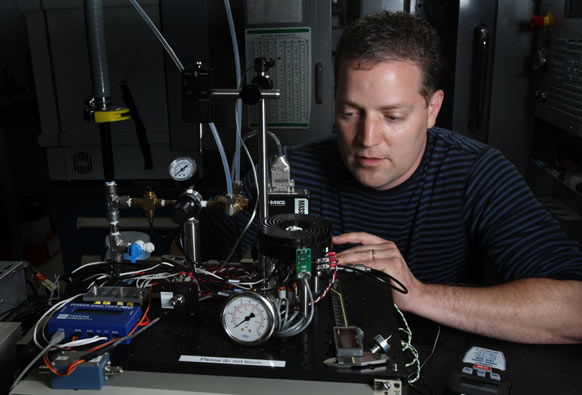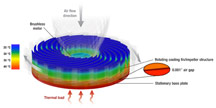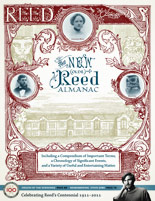
IRIS login | Reed College home Volume 90, No. 4: December 2011
The Small Chill

Researcher Jeff Koplow ’90 finds a new way to cool overheating computers.
By William Abernathy ’88

Like a puck on an air-hockey table, Koplow’s fan floats on a cushion of air, cooling the computer chip beneath it.
Illusration by Jeff Koplow
Deep inside the Department of Energy’s Sandia National Laboratories in Livermore, California, a black aluminum disk rests on a workbench, surrounded by a cluster of test equipment, wires, knobs, and dials. With its spiral fins, the disk looks vaguely like a child’s puzzle, but if it lives up to its potential, it could cut over 400 coal plants’ worth of electricity from America’s energy bill, according to its inventor, Jeff Koplow ’90.
When he graduated from Reed, Koplow was a chemistry major with an interest in instrumentation—tools scientists use to measure materials and phenomena. After earning a PhD in physical chemistry at Harvard, he began designing instrumentation to study pollution, climate change, and ozone depletion. This led him to the Naval Research Laboratory in Washington, D.C., where researchers had to fit laser-based instruments onto pilotless aircraft. Gas lasers were too heavy and fragile. Solidstate lasers were lighter and more rugged, but weren’t powerful enough.
Along with colleague Dahv Kliner, Koplow began looking into lasers built from doped optical fiber. “At that time,” recalls Kliner, “one kilowatt of peak power would have been enormously high for a fiber laser. We wanted to get to many kilowatts.” Conventional wisdom held that the fiber had to be kept as straight as possible, because bending the fiber scrambles the signal it carries. Since fiber lasers had been primarily used in low-power telecommunication applications (data instead of energy), no one had considered how bending the fiber scrambled the signal—interrupting a phone call was the literal and figurative end of discussion. Koplow and Kliner, however, ignored the dogma and discovered that carefully bending the fiber laser threw out noise, letting desired light propagate through the laser. This blew the lid off what had been considered a hard upper boundary, and yielded a thousandfold improvement in power output. It put fiber lasers into the megawatt range, creating new markets for high-energy fiber lasers in science, industry, and medicine.
Koplow could have coasted to an easy career in laser research, but had, by the mid-2000s, become restless. “I basically got to about age 40,” he says, “and asked myself, ‘Do I want to keep doing what I’m doing?’” Having built instruments to study the damage being done to the atmosphere, Koplow wanted to attack the climate problem at its source: energy.
Koplow approached the puzzle methodically. “The three biggest consumers of electricity are cooling, lighting, and motors,” he says. “The first problem I decided to take on was heat transfer, because it was a relatively self-contained thing, which I could do on my own without a big team.”
What is the “heat transfer problem”? If you’ve ever seen dust caked up inside a computer, been driven nuts by the drone of its cooling fan, or been fragged because your graphics card was too slow, you’ve encountered one aspect of it. The faster you run computer chips, the more heat they make, and their performance is limited by how fast they can get rid of that heat.
For the past 40 years, the state of the chip-cooling art has been to paste a finned metal heat sink to the processor, clamp a fan to it, and blow air at it. Air molecules, however, cling tenaciously to the heat sink by viscous forces in a boundary layer that traps heat as a blanket does. Blowing more air at the fins yields diminishing returns: it takes more power, makes more noise, and gathers more dust, which further blankets the heat sink. By 2003, processor speed stalled at around three billion processes a second (3 GHz), beyond which the heat transfer problem has stifled further progress.
Koplow returned to first principles. “If you want air flowing past the heat sink,” he explains, “all you care about is relative motion. You don’t really care if it’s the air moving, the heat sink moving, or both. My thought was, ‘Well, why not impart that relative motion directly?’” Koplow’s research led him to an obscure 1956 paper that described a peculiar effect: the surfaces of a spinning disk transferred heat far beyond conventional predictions by centrifugally thinning the boundary air layer. This mechanical jujistu uses the air’s own mass to overcome its viscosity and throws the boundary layer aside. “The first time I ran the idea by a fluid dynamics expert,” Koplow says, “he said he’d never heard of the effect, and was skeptical. But, indeed, it does exist, and it is quite powerful.”
The resulting design came to fruition in 2009, in a heat sink that spins on an air bearing—the same nearly frictionless bearing that floats a puck over an air hockey table. The prototype in Koplow’s lab delivers 10-fold improvement over a conventional heat sink. At the fin surface, Koplow measured a 30-fold improvement in heat transfer. The effect was proven.
Since then, Koplow’s invention has been wending its way through the patent office, Sandia’s technology transfer bureaucracy, and into the marketplace. Once released, it could transform energy-hungry server farms and consumer electronics. The cooler is cheap to manufacture, nearly silent, gathers no dust, and never wears out.
Computers are the beginning, but by no means the end. Every dirty air conditioner and every dust-fouled refrigerator coil getting air blown at it by an inefficient fan suffers the same problem as a computer with a dusty heat sink. If the cooler’s underlying principle can be scaled up to these larger uses, Koplow predicts it could trim 7 percent off the U.S.’s total electric bill. Sandia’s official release calls it a “fundamental breakthrough.”
What is striking about Koplow’s inventions is both their range (his patents improve everything from lasers to the patent system itself) and their elegance. “People think in retrospect they were obvious,” Koplow says. “You know you’ve accomplished something great when people say, ‘Oh, right, of course! That’s the way you want to do it.’” But the forehead-slapping conceals what really drives his ingenuity. Koplow’s office provides a clue: books cover almost every surface. Texts on thermodynamic jostle with organic chemistry, fluid dynamics, quantum mechanics, mathematics, optics, microprocessor design, classical mechanics, and an industrial supply catalog. Their titles betray no specialization; he specializes in all of it.
As he works to reinvent the light bulb and the electric motor (patents pending), Koplow reflects kindly on the approach to science he learned at Reed. “They teach you to think about things with great generality,” he says. “That’s something that’s becoming less and less common . . . Reed cultivated a keen interest in solving hard problems, understanding things. It pays a tremendous dividend.”
Reed also taught him the value of considering the big picture. “People ask, ‘How did you come up with this breakthrough?’ That’s where my style of thinking comes in,” Koplow says. “Where I say, ‘Look back and study again. How did we end up in this situation?’” Sometimes, it seems, you have to look back to go forward.


LATEST COMMENTS
steve-jobs-1976 I knew Steve Jobs when he was on the second floor of Quincy. (Fall...
Utnapishtim - 2 weeks ago
Prof. Mason Drukman [political science 1964–70] This is gold, pure gold. God bless, Prof. Drukman.
puredog - 1 month ago
virginia-davis-1965 Such a good friend & compatriot in the day of Satyricon...
czarchasm - 4 months ago
John Peara Baba 1990 John died of a broken heart from losing his mom and then his...
kodachrome - 7 months ago
Carol Sawyer 1962 Who wrote this obit? I'm writing something about Carol Sawyer...
MsLaurie Pepper - 8 months ago
William W. Wissman MAT 1969 ...and THREE sisters. Sabra, the oldest, Mary, the middle, and...
riclf - 10 months ago